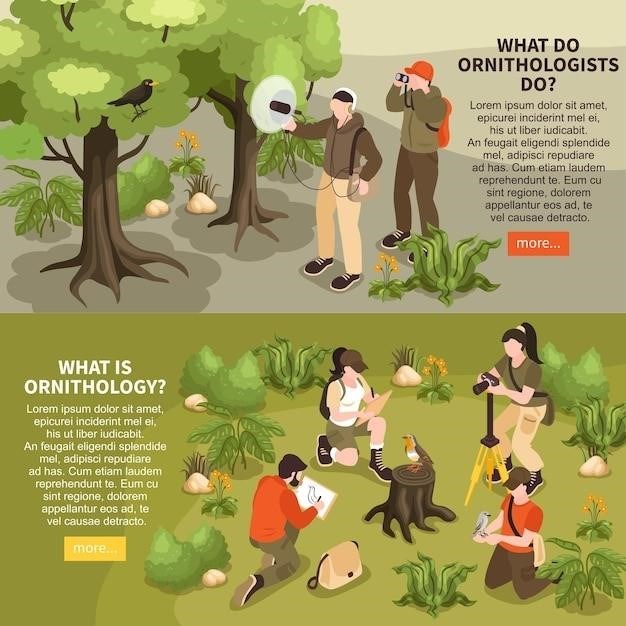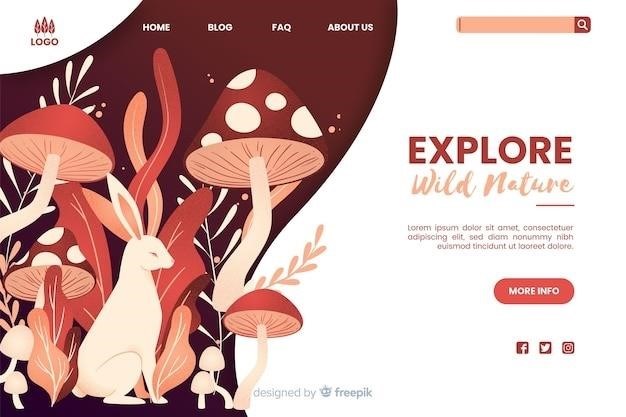
Overview
The Audubon Society Field Guide to North American Mushrooms is a comprehensive and authoritative guide to the mushrooms of North America. First published in 1981‚ this field guide has been updated to reflect the impact of climate change‚ making it the most comprehensive and current guide available.
The Audubon Society Field Guide to North American Mushrooms⁚ A Comprehensive Guide
The “National Audubon Society Field Guide to North American Mushrooms” by Gary Lincoff is a comprehensive field guide covering over 700 mushroom species. It features detailed descriptions‚ color photographs‚ and information on habitat‚ edibility‚ and toxicity. This field guide is known for its extensive coverage and user-friendly format‚ making it an essential tool for both amateur and experienced mushroom enthusiasts. The guide is organized by color and shape‚ making visual identification easier. It provides detailed descriptions of each species‚ including its habitat‚ seasonality‚ and edibility. The book also includes information on the ecology of mushrooms‚ their role in the ecosystem‚ and their importance for conservation.

Key Features
The Audubon Society Field Guide to North American Mushrooms stands out for its comprehensive coverage‚ visual identification tools‚ and detailed descriptions of each species.
Extensive Coverage
The Audubon Society Field Guide boasts an impressive coverage of over 700 mushroom species found in North America. This vast collection includes detailed descriptions and accompanying photographs‚ making it a valuable resource for both novice and experienced mushroom enthusiasts. The guide goes beyond simply identifying mushrooms‚ delving into their ecological roles‚ edibility‚ and potential toxicity. This depth of information ensures that users gain a comprehensive understanding of the fascinating world of mushrooms.
Visual Identification
The Audubon Society Field Guide emphasizes visual identification‚ making it an accessible and user-friendly resource. Featuring over 700 full-color photographs‚ the guide allows users to quickly and accurately identify mushrooms based on their appearance. The photographs are organized by color and shape‚ further simplifying the identification process. This visual approach is particularly beneficial for beginners‚ enabling them to confidently distinguish between different species in the field.
Detailed Descriptions
Accompanying the stunning photographs‚ the Audubon Society Field Guide provides detailed descriptions of each mushroom species. These descriptions cover key features‚ including size‚ shape‚ color‚ texture‚ and habitat preferences. The guide also includes information on the edibility and toxicity of each mushroom‚ along with notes on its culinary uses or potential dangers. The inclusion of both visual and textual information makes the guide a comprehensive resource for both novice and seasoned mushroom enthusiasts‚ offering a deeper understanding of the fascinating world of fungi.
Content
This guide covers 703 species of mushroom in full detail and provides notes on hundreds more.
Mushroom Identification
The Audubon Society Field Guide to North American Mushrooms excels in its comprehensive coverage of mushroom identification. With over 700 species detailed through color photographs and descriptive text‚ this guide equips users with the tools for accurate identification in the field. The guide employs a visual organization‚ grouping mushrooms by color and shape for easy navigation. This layout allows users to quickly narrow down their search and find the relevant information. The detailed descriptions include key features like cap shape‚ gill attachment‚ spore print color‚ and habitat preferences‚ aiding in precise identification. Furthermore‚ the guide includes information on look-alikes‚ helping users avoid confusion and potential misidentification‚ especially when dealing with edible and poisonous species.
Habitat and Ecology
Beyond identification‚ the Audubon Society Field Guide delves into the fascinating world of mushroom ecology. It provides insights into the intricate relationships mushrooms have with their surroundings. The guide highlights the diverse habitats where different species thrive‚ from forests and meadows to grasslands and urban environments. It explores the symbiotic relationships mushrooms form with trees‚ particularly mycorrhizal associations‚ where fungi exchange nutrients with tree roots. This understanding of habitat and ecological interactions helps users interpret mushroom presence and understand their role in the ecosystem. The guide also discusses the factors influencing mushroom growth‚ including seasonal variations‚ rainfall‚ and temperature‚ enabling users to predict fruiting seasons and optimize foraging opportunities.
Edibility and Toxicity
The Audubon Society Field Guide emphasizes the importance of safety when it comes to mushrooms. It provides detailed information on the edibility and toxicity of each species‚ clearly labeling those that are safe for consumption‚ those that are potentially poisonous‚ and those that are known to be deadly. The guide includes descriptions of the symptoms associated with mushroom poisoning‚ enabling users to recognize potential risks and seek immediate medical attention if necessary. It also highlights the need for caution‚ emphasizing that even experienced foragers should always double-check their identifications and avoid consuming any mushroom about which they have doubts. The guide advocates for responsible mushroom foraging practices‚ promoting awareness and respect for the natural environment.
Conservation
The Audubon Society Field Guide to North American Mushrooms recognizes the importance of preserving mushroom populations and their habitats. The guide emphasizes the need for sustainable foraging practices‚ encouraging readers to harvest only what they need and to leave the rest for future growth and ecological balance. It highlights the role of mushrooms in the ecosystem‚ explaining their importance in decomposition‚ nutrient cycling‚ and symbiotic relationships with trees. The guide also discusses the impact of habitat loss‚ pollution‚ and climate change on mushroom populations‚ emphasizing the need for responsible land management and conservation efforts. By promoting awareness of these issues‚ the Audubon Society Field Guide aims to inspire readers to become stewards of mushroom biodiversity and to protect the delicate balance of the natural world.

Usage and Benefits
The Audubon Society Field Guide to North American Mushrooms serves as an invaluable resource for mushroom enthusiasts‚ educators‚ and conservationists‚ offering practical guidance for identification‚ foraging‚ and environmental awareness.
Foraging and Identification
The Audubon Society Field Guide to North American Mushrooms is an indispensable tool for mushroom foragers and enthusiasts. Its comprehensive coverage of over 700 species‚ coupled with detailed descriptions and vivid photographs‚ enables users to confidently identify mushrooms encountered in the wild. The guide’s visual organization by color and shape facilitates quick and accurate identification‚ allowing foragers to distinguish edible varieties from poisonous ones with ease. The inclusion of information on habitat and ecology provides valuable insights into the preferred growing conditions of various mushroom species‚ aiding foragers in their search and ensuring responsible harvesting practices.
Educational Resource
Beyond its practical applications for mushroom foraging‚ the Audubon Society Field Guide to North American Mushrooms serves as an exceptional educational resource. Its detailed descriptions delve into the fascinating world of fungi‚ encompassing aspects of their biology‚ ecology‚ and evolutionary history. The guide provides a comprehensive understanding of the intricate relationships between mushrooms and their environments‚ highlighting their vital roles in ecosystems. It also explores the cultural significance of mushrooms in various societies‚ from culinary traditions to medicinal uses. This wealth of information makes the guide an invaluable tool for educators‚ students‚ and anyone seeking to expand their knowledge of the fungal kingdom.
Conservation Awareness
The Audubon Society Field Guide to North American Mushrooms not only empowers individuals to identify and appreciate mushrooms but also fosters a deeper understanding of their ecological significance. By highlighting the interconnectedness of fungi within ecosystems‚ the guide emphasizes the importance of responsible foraging practices. It encourages readers to practice sustainable harvesting methods‚ respecting the delicate balance of nature and ensuring the long-term health of mushroom populations. Moreover‚ the guide sheds light on the threats facing various mushroom species‚ including habitat loss‚ climate change‚ and over-collection. By raising awareness about these challenges‚ the guide inspires readers to contribute to conservation efforts and become stewards of the fungal world.
Availability and Purchase
The Audubon Society Field Guide to North American Mushrooms is widely available for purchase both online and in physical bookstores.
Online Retailers
For those seeking the convenience of online shopping‚ the Audubon Society Field Guide to North American Mushrooms is readily available through various retailers such as Amazon.com. This platform provides a comprehensive selection of books‚ including this essential guide for mushroom enthusiasts. With its user-friendly interface and secure payment options‚ Amazon offers a seamless shopping experience for acquiring this valuable resource. Additionally‚ online retailers like Goodreads and FarmSteady allow for easy browsing and purchasing‚ ensuring a convenient and accessible way to obtain the Audubon Society Field Guide to North American Mushrooms.
Bookstores
For those who prefer a more traditional shopping experience‚ the Audubon Society Field Guide to North American Mushrooms can be found in various bookstores across the country. Local bookstores often carry a diverse selection of field guides and nature books‚ providing a chance to browse and discover other related titles. Additionally‚ larger bookstore chains like Barnes & Noble and Books-A-Million typically stock popular field guides‚ ensuring a wider accessibility for those seeking this valuable resource. Visiting a bookstore offers the opportunity to personally examine the book‚ compare it with other field guides‚ and receive assistance from knowledgeable staff‚ making it an enriching shopping experience.
Reviews and Reception
The Audubon Society Field Guide to North American Mushrooms has received widespread critical acclaim and positive user feedback for its comprehensive coverage‚ detailed descriptions‚ and visually appealing photographs.
Critical Acclaim
The Audubon Society Field Guide to North American Mushrooms has been praised by critics for its comprehensiveness‚ accuracy‚ and user-friendliness. Reviews consistently highlight the guide’s extensive coverage of over 700 mushroom species‚ its detailed descriptions‚ and its high-quality photographs. The guide is lauded for its ability to assist both novice and experienced mushroom enthusiasts in accurately identifying and understanding the diverse world of North American fungi.
User Feedback
User feedback for the Audubon Society Field Guide to North American Mushrooms is overwhelmingly positive. Readers praise the guide’s clear and concise language‚ its helpful illustrations‚ and its ability to make mushroom identification accessible to a wide audience. Many users appreciate the guide’s focus on both identification and ecological information‚ making it a valuable resource for mushroom enthusiasts‚ naturalists‚ and anyone interested in learning more about the fascinating world of fungi. The guide’s durability and portability are also frequently mentioned as positive attributes‚ making it a practical and reliable companion for outdoor adventures.
Comparison with Other Field Guides
The Audubon Society Field Guide is often compared to David Arora’s “Mushrooms Demystified‚” another popular guide. While “Mushrooms Demystified” is known for its detailed descriptions and focus on edibility‚ the Audubon guide provides a more comprehensive overview of North American mushrooms‚ including their identification‚ habitat‚ and ecology.
Mushrooms Demystified
The Audubon Society Field Guide to North American Mushrooms is often compared to “Mushrooms Demystified‚” a popular field guide by David Arora. While “Mushrooms Demystified” is known for its in-depth descriptions and focus on edibility‚ the Audubon guide offers a broader perspective on North American mushrooms. It covers a wider range of species‚ providing information not only on identifying and consuming them but also on their ecological roles and conservation status. The Audubon guide’s comprehensive approach makes it a valuable resource for both novice and experienced mushroom enthusiasts.
Regional Field Guides
While the Audubon Society Field Guide to North American Mushrooms offers a comprehensive overview of the continent’s fungal diversity‚ some mushroom enthusiasts prefer the specificity of regional field guides. These guides focus on the species found in a particular geographic area‚ providing more detailed information about their local habitats‚ seasonality‚ and potential hazards. For those seeking a more localized approach to mushroom identification‚ exploring regional field guides alongside the Audubon guide can enhance their understanding of the fungal world in their own backyard.
The Audubon Society Field Guide remains a valuable resource for mushroom enthusiasts‚ offering a comprehensive guide to identifying and understanding the diverse world of North American fungi.
The Audubon Society Field Guide⁚ An Essential Tool for Mushroom Enthusiasts
The Audubon Society Field Guide to North American Mushrooms stands as a testament to the dedication of Gary Lincoff and the National Audubon Society in providing a comprehensive resource for mushroom identification. This guide‚ with its extensive coverage of over 700 species‚ detailed descriptions‚ and vibrant photographs‚ has become a cornerstone for both novice and experienced mushroom enthusiasts. Whether you’re a seasoned forager or a curious beginner‚ this field guide equips you with the knowledge and visual tools necessary to confidently navigate the fascinating world of mushrooms. Its comprehensive nature makes it an indispensable tool for anyone seeking to explore the diverse array of fungi that grace the North American landscape.